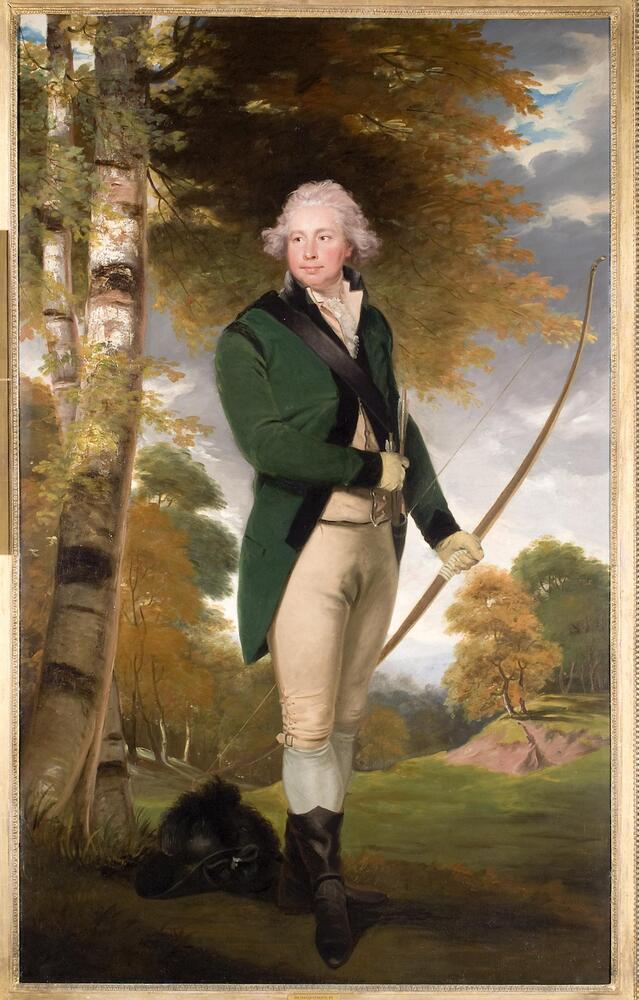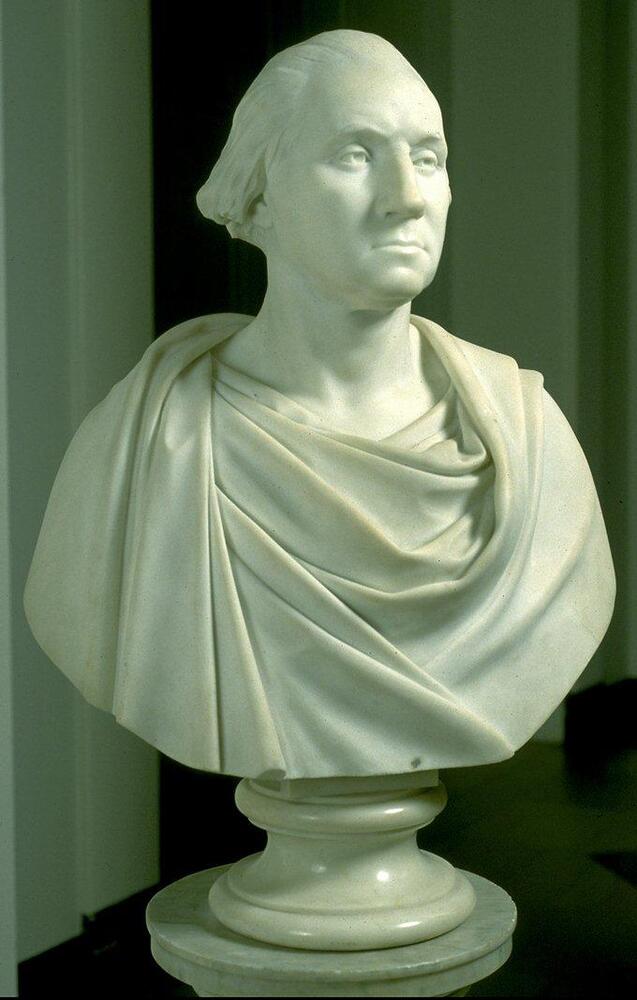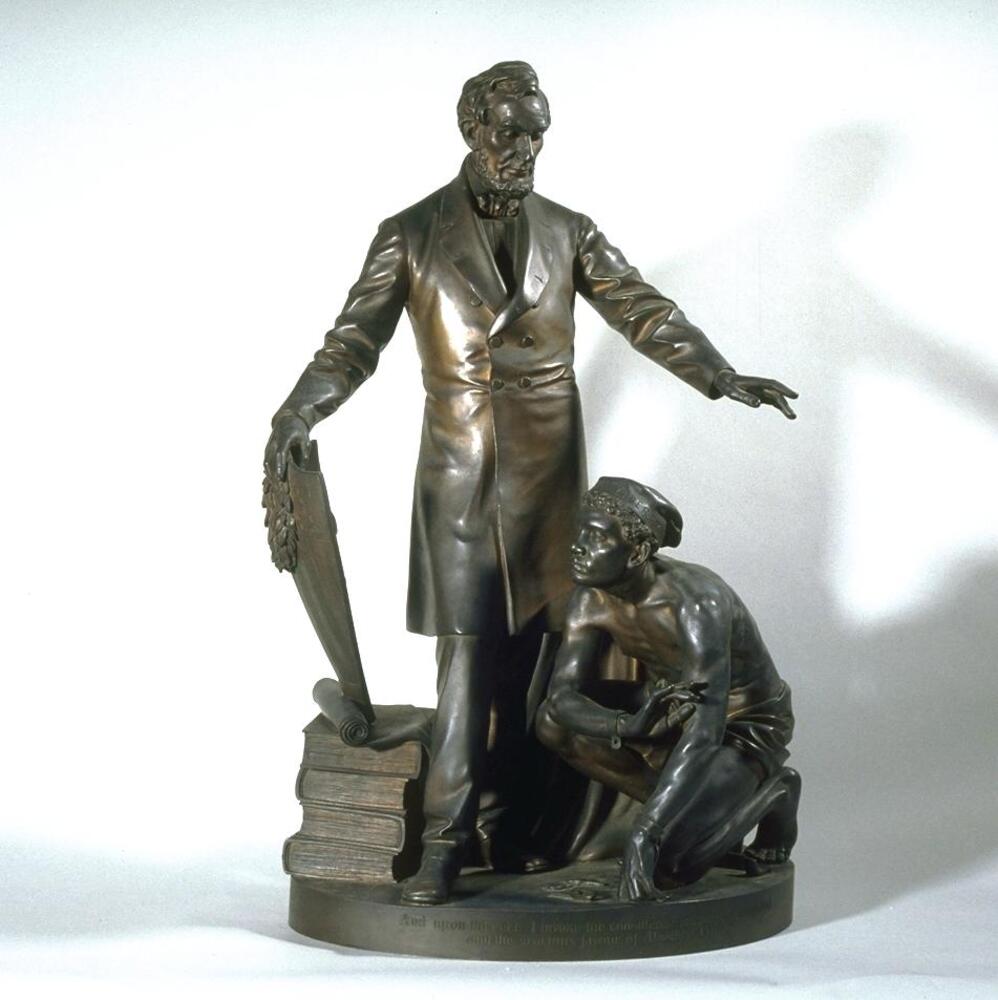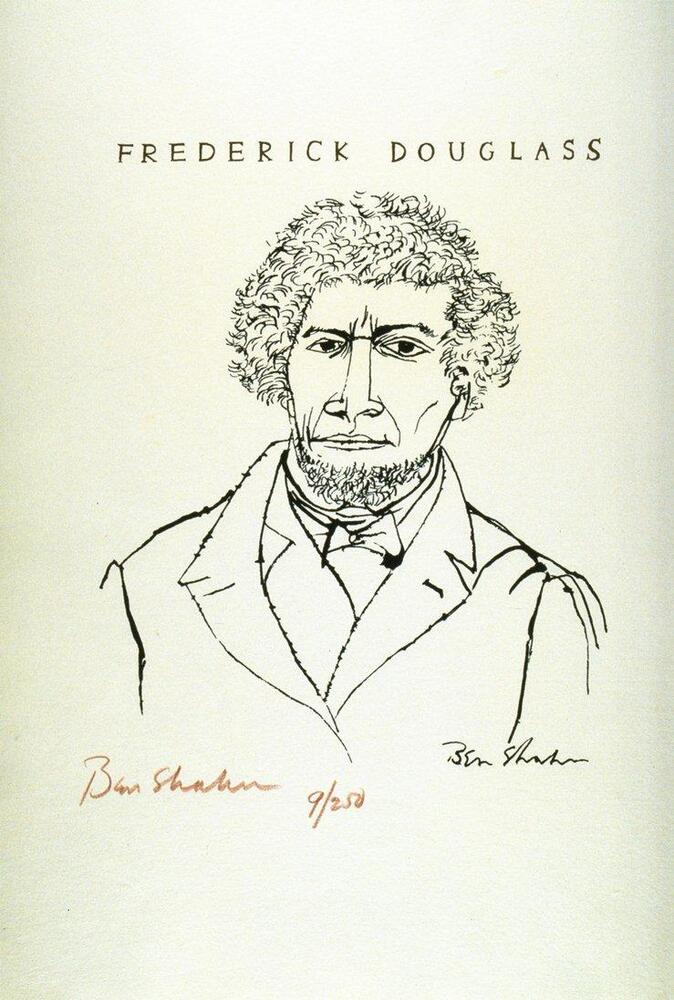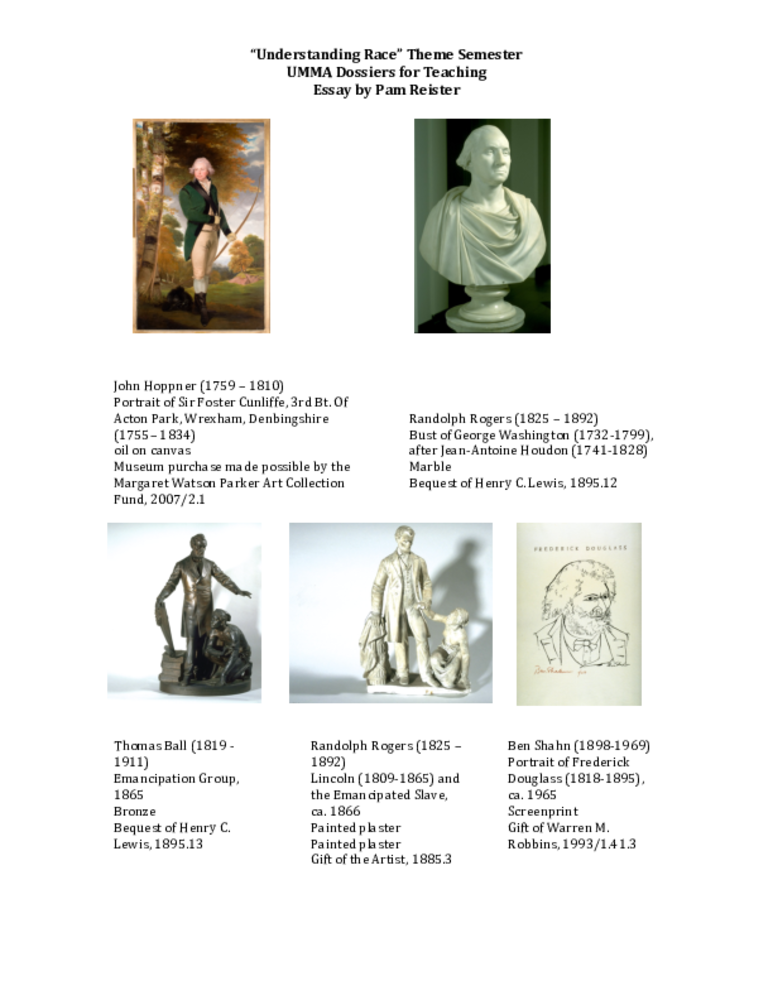Essay: Cunliffe, Washington, Lincoln, and Douglass
Understanding Race Essay by Pamela Reister
Introduction
Often the stories we tell about 18th and 19th century European and American art revolve around the heroism of the people in the paintings or the talent of the artists who made them.
Other stories can be told, however. In the context of the University of Michigan’s Theme Semester “Understanding Race,” for example, a historical trajectory of the African slave trade is revealed when particular pieces are connected. Sir Foster Cunliffe (1755-1834) lived on the wealth amassed by his father and grandfather in the triangle of slave trade between Great Britain, Africa, and America. George Washington (1732-1799) was a slave owner whose ideas about slavery changed over his lifetime and between his private and public life. Abraham Lincoln (1809-1865) was called the “Great Emancipator.” Lincoln, however, did not publicly endorse suffrage for black freedmen a fact that made Frederick Douglass (1818-1895)—a former slave and eminent human rights activist in the abolitionist movement—not support Lincoln in his bid for the presidency in 1864.
Slavery and racism are so closely connected in recent centuries that some people believe one created the other.
As the Trinidadian historian of slavery Eric Williams put it: “Slavery was not born of racism: rather, racism was the consequence of slavery.” And, one should add, the consequence of modern slavery at the dawn of capitalism. While slavery existed as an economic system for thousands of years before the conquest of America, racism as we understand it today did not exist.[1]
Opinions on this issue differ, of course and may provide lively conversation among students. Some details about slavery and abolition are revealed in discussion of the following works of art.
PORTRAIT OF SIR FOSTER CUNLIFFE
The Sitter/Subject
Sir Foster Cunliffe, 3rd Baronet of Acton Park, Wrexham, Denbighshire (1787–1834) was the son and grandson of slave traders, whose family business included five trading posts in Virginia and up to 26 ships that worked the transatlantic slave trade between Africa, the Americas, and England. Sir Foster’s grandfather, Foster Cunliffe (1682–1758), became the main slave trader in Liverpool and mayor on three occasions. His son, Ellis, was MP for Liverpool from 1755 to 67.
Liverpool was a major slaving port and its ships and merchants dominated the transatlantic slave trade in the second half of the 18th century. The town and its inhabitants derived great civic and personal wealth from the trade which laid the foundations for the port's future growth.
The growth of the trade was slow but solid. By the 1730s about 15 ships a year were leaving for Africa and this grew to about 50 a year in the 1750s, rising to just over a 100 in each of the early years of the 1770s. Numbers declined during the American War of Independence (1775-83), but rose to a new peak of 120-130 ships annually in the two decades preceding the abolition of the trade in 1807. Probably three-quarters of all European slaving ships at this period left from Liverpool. Overall, Liverpool ships transported half of the 3 million Africans carried across the Atlantic by British slavers. [2]
Though the firm stopped trading in 1759, Sir Cunliffe acquired Acton Park with the wealth inherited from his father and subsequently became an active member of English society.
In this grand manner portrait, Cunliffe is attired in archery uniform (green coat, buff yellow breeches, and hessian boots) —fitting for the founder of the Royal Society of British Bowsmen. Cunliffe was also a member of the Wrexham Yeomanry Cavalry during the Napoleonic Wars, where he served as a Major Commandant. Posed elegantly in a tensile stance mirrored by adjacent trees, Cunliffe gazes away from his bow, his head spotlighted against his thatch of white hair and the dark leafy canopy. The deeply recessed landscape suggests the enormity of the family estate.
As a university art museum with global reach, UMMA takes seriously its responsibility to collect works of art that do not shy away from controversial or uncomfortable topics. When this painting—that not only embodied exceptional artistic merit but also tackled head on one of the most significant moral and social justice issue—became available, the museum lost no time in purchasing it. [3]
The Artist
John Hoppner was recognized early as a “Lad of Genius” by King George III, and was tutored in the arts by the keeper of the King’s drawings and medals. In 1775, when he was 19 years old, Hoppner entered the Royal Academy Schools, where he won several medals. Art, style, and taste in eighteenth-century England were directed by the British Royal Academy. Founded in 1768, the Academy served as a national organizational society for the fine arts; it functioned as a governing body, a school, and a host for exhibitions of painting, sculpture, and architecture. One of the most important aspects of the Royal Academy was the education it offered budding artists. The Academy cultivated a methodical, scholarly approach to painting that remained a convention in British art until the end of the nineteenth century.
Upon his marriage Hoppner lost his royal allowance and thus had to take up portrait paintings to support his family. As the years progressed, his sitters grew more and more distinguished; in 1785, he painted three portraits of King George III’s youngest daughters. Ten years later, he had established himself as the principal painter to the Prince of Wales. By 1789, when he was appointed portrait artist to the future King George IV, Hoppner was widely regarded to be the most important portraitist in England. In 1795 he was elected Royal Academician, one of the elite artist-members responsible for governing Britain’s Royal Academy of Arts.
BUST OF GEORGE WASHINGTON
The Sitter/Subject
George Washington (1732-99) began his rise to national importance when he pledged to raise, finance and lead 1000 men to relieve Boston from the British siege just prior to the Revolutionary War. The following year, the Continental Congress appointed him commander of the army. At the Constitutional Convention in 1787, Washington was one of Virginia's five delegates and was unanimously elected president of the Convention. After the Constitution was drafted, he worked for its adoption and later was unanimously elected the nation's first President. Washington retired in March 1797, and, except for a brief stint as Commander-in-Chief of the army in 1798, devoted the remaining two and a half years of his life to the affairs of his estate at Mt. Vernon.[4] His gentleman’s life at Mt Vernon was similar in many ways to Cunliffe’s at Acton Park.
Although he privately expressed opposition to the institution of slavery, Washington was a slave owner all his life. At the time of his death he owned 123 slaves and nearly 200 more lived at Mount Vernon (including those belonging to his wife). His legislative actions gave a mixed message. In 1791 he authorized emergency aid to French slave owners in Haiti to suppress a slave rebellion, but, in 1789, Congress passed and he signed a law that reaffirmed a previous ban on slavery in the NW Territory. In 1793, he signed the Fugitive Slave Law which provided for the right of slaveholders to recapture slaves. He included a provision in his will to free his slaves upon Marth’a’s death (George preceded Martha in death) and he freed William Lee, his longtime personal valet, outright.
Historian Dorothy Twohig argues that Washington "did not speak out publicly against slavery because he did not wish to risk splitting apart the young republic over what was already a sensitive and divisive issue."[5]
The Artist
An American expatriate sculptor, Randolph Rogers grew up in Ann Arbor but spent much of his adult life in Rome. As was typical of many aspiring 19th-century American sculptors, Rogers went to Italy to study classical Greek and Roman art as an essential prelude to becoming an accomplished artist. Although he was accustomed to studying and copying from classical sculpture, he also created replicas of 18th-century works, such as French sculptor Jean-Antoine Houdon’s Bust of George Washington.
Houdon modeled his bust of George Washington from life. In 1785 Houdon along with three assistants stayed at Mt. Vernon taking detailed measurements of Washington's arms, legs, hands and chest and making a mold of his face and sculpting wet clay models, which he used to produce countless commissioned sculptures in numerous variations. Rogers likely copied Houdon’s bust from photographs or prints of the work, first modeling it in clay, then casting it in plaster to be given to stonecutters who sculpted it in marble, as was common practice among many sculptors of the time.[6]
This white marble bust of George Washington has drapery wrapped loosely around his shoulders. His calm and reserved expression stares into space. This heroicized likeness would have appealed to Rogers’ Neoclassical taste. Rogers completed the bust of Washington in 1868, just three years after the end of the American Civil War, during a time of great change and an increasing desire on both moral and aesthetic grounds to return to the order, democracy, and calm grandeur of the Roman Republic.
LINCOLN AND EMANCIPATION GROUPS
Emancipation, …was not a historical event that could be tidily defined, demarcated, and commemorated. Even after the final abolition of slavery in 1865, the bitter struggle over the meaning of freedom and how it translated into social and political rights continued to intensify. … the sculptors of emancipation [were put] in a distinctly problematic position. They were testing the limits of what was culturally possible before anyone had a clear idea of what those cultural limits were.[7]
The Artists and Art Works
Like Rogers, Thomas Ball was an American sculptor from Boston who lived for some time in Florence. Unlike other ex-patriot sculptors living in Italy at the time, Ball favored greater naturalism than the neoclassical style favored by others. Ball created several monuments of important Americans including George Washington, Daniel Webster and Henry Clay.
At the end of the Civil War (1861–65) there was an effort to promote an American Renaissance and to beautify cities with civic monuments and public sculpture. Sculptors, including Ball and Rogers (for some info on Rogers, see George Washington section above), were commissioned to produce memorials that addressed themes of war and slavery and to commemorate military heroes, from the common soldier to President Abraham Lincoln.
Thomas Ball’s bronze study or maquette for the Emancipation Memorial, aka, The Freedmen’s Memorial, erected in Washington D.C.’s Lincoln Park in 1876, depicts Abraham Lincoln as the “Great Emancipator” freeing a slave, establishing a narrative of theoretical peace and unity. However…
From its extraordinary and much-publicized origins, the campaign for the Freedmen’s Memorial was mired in contradictions. The story begins after Lincoln’s assassination with a five-dollar donation entrusted by an ex-slave named Charlotte Scott to her ex-master for a monument to the martyr-president. The local newspaper in Marietta, Ohio, instantly publicized the act, and others took notice. …That image of black deference to white patronage then became reproduced in the institutional structure of the campaign—and ultimately in the monument itself. African Americans, mostly soldiers, contributed the cash, while the white sponsors collected the money and decided how to spend it.[8]
Roger’s sculpture depicts a standing Abraham Lincoln, his right hand resting upon a small column and his left hand holding the arm of a crouching African American female figure. Rogers’ plaster cast was a maquette for an emancipation monument which when completed and erected in Philadelphia in 1871, shows Lincoln, seated alone, signing the proclamation.
At the time of the Emancipation Proclamation (1863) and further after the assassination of Abraham Lincoln and the adoption of the Thirteenth Amendment (1865) which officially outlawed slavery and involuntary servitude, monumental public sculpture was commissioned to commemorate these events.[9] In general, emancipation was not depicted as an independent subject but was connected to Abraham Lincoln who was shown as the primary historical agent of these developments.
In addition to commemorating emancipation, the sculptors who created monuments of Lincoln together with a representative freed slave, had to address the representation of an interracial group, and in the case of Roger’s example, an intergendered group.
Both the Ball’s and Rogers’ studies show Lincoln in the act of manumission—the master’s voluntary release of a slave from slavery. In the Ball monument, Lincoln does not touch the man who is kneeling at his feet but holds his hand over his head in a benedictory gesture. Rogers, on the other hand, shows Lincoln grasping the wrist of the woman kneeling next to him—not the hand, which could be seen as “romantic gallantry.”[10] Both of the kneeling figures are semi-nude, as slaves were often portrayed at the time. This nudity had the effect of further distancing them from the status of the elaborately clothed Lincoln and adding an element of vulnerability and, in the figure of the woman, sexuality.
FREDERICK DOUGLASS
The Subject
Frederick Douglass
was a leading spokesperson for the abolition of slavery and for racial
equality. The son of a slave woman and an unknown white man, "Frederick
Augustus Washington Bailey" was born in February of 1818 on Maryland's
eastern shore. He spent his early years with his grandparents and with an aunt,
seeing his mother only four or five times before her death when he was seven.
During this time and at subsequent locations, he was exposed to the
degradations of slavery, witnessing firsthand and experiencing brutal whippings
and spending much time cold and hungry. When he was eight he was sent to
Baltimore to live with a ship carpenter. There he learned to read and first
heard the words abolition and abolitionists. "Going to live at
Baltimore," Douglass would later say, "laid the foundation, and
opened the gateway, to all my subsequent prosperity."
On January 1, 1836, Douglass resolved, and later made good on that resolution,
that he would be free by the end of the year—not including details of his
escape to freedom in his earliest autobiographies in order to protect the
people involved. Always striving to educate himself, Douglass continued his
reading. He joined various organizations in New Bedford, including a black
church. He attended Abolitionists' meetings. He subscribed to William Lloyd
Garrison's weekly journal, the Liberator. Douglass and Garrison met and
developed mutual appreciation for their thoughts and work. At age 23, Douglass
gave a speech at the Massachusetts Anti-Slavery Society's annual convention in
Nantucket. Of the speech, one correspondent reported, "Flinty hearts were
pierced, and cold ones melted by his eloquence.” It was the launch of a career
that would continue throughout Douglass' long life.
The views of Garrison and Douglass
ultimately diverged. Garrison represented the radical end of the abolitionist
spectrum. Douglass became more of a pragmatist. In 1851 he announced that he
did not assume the Constitution was a pro-slavery document, and that it could
even "be wielded in behalf of emancipation," especially where the
federal government had exclusive jurisdiction. Douglass also did not advocate
the dissolution of the Union, since it would isolate slaves in the South. This
led to a bitter dispute between Garrison and Douglass that, despite the efforts
of others such as Harriet Beecher Stowe to reconcile the two, would last into
the Civil War.
Despite apprehensions that the information might endanger his freedom, in 1845
Douglass published the first of three iterations of his autobiography. Frederick
Douglass would continue his active involvement to better the lives of African
Americans. He conferred with Abraham Lincoln during the Civil War and recruited
northern blacks for the Union Army. After the War he was appointed to several
political positions and fought for the rights of women and African Americans
alike.[11]
The Artist
Ben Shahn immigrated to the United States as a child from his native Lithuania, and was apprenticed to a lithographer after finishing elementary school. In the 1920s, he studied at New York University and City College, and very briefly at the National Academy of Design. Shahn's first major success came with the 1932 exhibition of his series The Passion of Sacco and Vanzetti. Shahn once said that he paints two things, "what I love and what I abhor," and during the Depression years his scenes of children playing in concrete urban parks, and of miners and construction workers engaged in their trades, reflect his admiration for the working American and his abhorrence of injustice and oppression. Throughout the 1930s Shahn worked for various government programs, and when the United States entered World War II, he joined the Graphic Arts Division of the Office of War Information, although only two of the many posters he designed were published. In the 1940s, Shahn turned to what he called “personal realism." His late work is often symbolic, allegorical, or religious and reflects his belief that "if we are to have values, a spiritual life, a culture, these things must find their imagery and their interpretation through the arts."[12]
In 1965, Shahn did four studies of the abolitionist orator and publisher, Frederick Douglass. Editions of 250 were made of each study in support of the fund-raising efforts of the Frederick Douglass Institute of Negro Arts and History, which opened its doors to the public in 1964 as the Museum of African Art. Shahn was among the founding trustees of this organization.[13] UMMA owns copies of all four prints in this series.
IDEAS FOR TEACHING
1. Discuss the following statement: “Slavery was not born of racism: rather, racism was the consequence of slavery.”
2. “UMMA takes seriously its responsibility to collect works of art that do not shy away from controversial or uncomfortable topics.” Ask students to discuss whether they would have purchased this painting.
3. The British-Nigerian artist, Yinka Shonibare, created a contemporary interpretation of Sir Foster Cunliffe that was displayed at London’s Victoria and Albert Museum for the recognition of the bicentennial of abolition of slavery in Great Britain (1807). Here is a short description and a few pictures of the piece.
[This work of sculpture illustrates] how we might question the interconnections between the slave trade and our perception of national cultural heritage. Yinka Shonibare's 'Sir Foster Cunliffe, Playing' (2007) figured the grandson of a prominent Liverpool slave merchant as a headless archer dressed in period style, although his clothes have been tailored from brightly coloured batik cloth.
While we now consider batik a characteristic West African product, it was originally a British export to Africa, derived from the Dutch appropriation of Indonesian printing techniques. It became extremely popular in Africa and favoured over traditional costume as a sign of social prestige. By dressing Cunliffe this way, Shonibare is pointing to the intertwining of the constructions of 'African' and 'British' identities through exchange; Britain traded textiles for slaves many of whom were used to produce cotton which was then brought back to Britain to supply the textile industry. [14]
Discuss with your students other interventions that might be made to illustrate the complexity of the slave trade and its legacy. Creative and/or art students may want to make their own interventions. Look at UMMA’s Shonibare house and discuss how its strategies are similar and different.
3) Review the short biographies of the artists who created these works. How is their position in society similar to or different from their subjects? How do their works contribute to our understanding of history, slavery, race?
4) The slave figures in the Emancipation Groups are shown in attitudes of submission. Imagine other poses for these figures with Lincoln and discuss the impact a change in posture would create.
5) In his autobiography, Narrative of the Life of Frederick Douglass, an American Slave, (1845), Frederick Douglass recounts his meeting with a woman in whose house he will be in service. At the first introduction he states:
My new mistress proved to be all she appeared when I first me her at the door,--a woman of the kindest heart and finest feelings. She had never had a slave under her control previously to myself, and prior to her marriage she had been dependent upon her own industry for a living. …She did not deem it impudent or unmannerly for a slave to look her in the face. The meanest slave was put fully at ease in her presence, and none left without feeling better for having seen her. (chap. VI)
Later he writes:
Slavery proved as injurious to her as it did to me. When I went there, she was a pious, warm and tenderhearted woman. There was no sorrow or suffering for which she had not a tear. …Slavery soon proved its ability to divest her of these heavenly qualities. Under its influence, the tender heart became stone, and the lamblike disposition gave way to one of tiger-like fierceness. (chap. VII)
[1]Lance Selfa, “Slavey and the Origins of Racism,” International Socialist Review, Nov-Dec., 2002, http://www.isreview.org/issues/26/roots_of_racism.shtml. Quote within this reference is to Eric Williams, Capitalism and Slavery (New York: Perigee Books, 1980), p. 7.
[2] “Liverpool and the Slave Trade,” International Slavery Museum, http://www.liverpoolmuseums.org.uk/ism/slavery/europe/liverpool.aspx This site has a good, concise history of the slave trade including primary sources from Africans and Europeans.
[3] Much of the information about this painting is from Stephanie Rieke, “UMMA Acquires Monumental English Portrait,” Nov/Dec, 2007, http://www.umma.umich.edu/collections/acquisitions/hoppner.html . Other sources for information on this work include:
Schofield, et al. “London.” In Grove Art Online. Oxford Art Online, http://www.oxfordartonline.com:80/subscriber/article/grove/art/T051656pg6 (access 22 July 2008).
“Sir Foster Cunliffe – The Painting”. The Wrexham Borough Council Homepage http://www.wrexham.gov.uk/english/heritage/foster_cunliffe_appeal/painting/index.htm (accessed 02 May 2008).
Skipton, Horace Pitt Kennedy. John Hoppner. London: Menthuen & Co., 1905.
Wilson, John. “Hoppner, John.” In Grove Art Online. Oxford Art Online, http://www.oxfordartonline.com:80/subscriber/article/grove/art/T038921 (accessed 22 July 2008).
[4] Much of this paragraph is from http://www.publicartinla.com/CivicCenter/washington.html
[5] Dorothy Twohig, "‘That Species of Property’"Washington's Role in the Controversy Over Slavery, 1997, http://gwpapers.virginia.edu/articles/twohig_2.html
[6] See H.H. Arnason, The Sculptures of Houdon (New York: Oxford University Press, 1975), 72-77; and http://www.monticello.org/site/research-and-collections/george-washington-bust-houdon-sculpture
[7] Kirk Savage, Standing Soldiers, Kneeling Slaves: Race, War, and Monument in Nineteenth-Century America, Princeton University Press, New Jersey, 1997, p. 65.
[8] Savage, pp. 90-92.
[9] President Lincoln and other Republicans were concerned that the Emancipation Proclamation, which only declared the freedom of slaves in ten Confederate states then in rebellion, would be seen as a temporary war measure, since it was solely based on Lincoln's war powers. The Proclamation did not free any slaves in the border states nor itself make slavery illegal.[1] FROM WIKIPEDIA
[10] Savage, p. 77
[11] This short bio is based on an excerpt from the PBS website documenting their Africans in America, 4-part broadcast. See: http://www.pbs.org/wgbh/aia/part4/4p1539.html
[12] This short bio of Shahn is from Virginia M. Mecklenburg Modern American Realism: The Sara Roby Foundation Collection (Washington, D.C.: Smithsonian Institution Press for the National Museum of American Art, 1987), accessed at http://americanart.si.edu/collections/search/artist/?id=4384
[13] Warren M. Robbins, from “Ben Shahn on Human Rights,” exhibition brochure. Accessed at http://www.thekingcenter.org/archive/document/ben-shahn-human-rights
1 Comment
— by charlie puth puth (January 5 2019 @ 3:23 am)
0 Tags & 0 Keywords
Tags
Part of 2 Learning Collections
<p>Understanding Race Essay by Pamela Reister</p>
<p><br></p>
<p><span style="font-size: 14px;">History of wester...
<p><br></p>
<p><br></p>
<p><br></p>
<p>Understanding Race Essay by Pamela Reister</p>
Created For
K-12 EducatorK-12 Student
Museum Visitor
UMMA Docent
UMMA Staff
University Faculty
University Student
Rate this Resource
AVG: 0 | Ratings: 0
& Author Notes
Creative Commons by-nc-saLast Updated
November 14, 2017 11:04 a.m.Report
Reporting Policy
